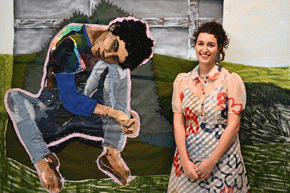Has Israel’s security apparatus learned nothing from Oct. 7?
If Mohammed Abu Salmiya hadn’t filmed a couple of hate-filled videos upon his triumphant return to Gaza on Monday morning, the Shifa Hospital director’s release from Israeli incarceration would have remained under the radar.

Hostages being moved inside Shifa Hospital in Gaza City. Source: IDF Spokesperson’s Unit.
But Abu Salmiya, one of some 50 Palestinian detainees let out of the Sde Teiman military base in southern Israel and whisked back to the terrorist enclave from whence they came, was proud to highlight his ordeal.
It’s lucky he did. Otherwise, the fact that he’s now back in the business of using his illustrious license and position to store weapons and abuse hostages would have escaped notice—not only of the Israeli public, but of the very government that’s supposed to have learned a lesson or two on and since Oct. 7.
In his clips, Abu Salmiya failed to mention his own key role in Hamas’s atrocities, which involved aiding and abetting the perpetrators of the massacre and mass abductions. This isn’t mere speculation; all evidence of Shifa operations is fully documented, with footage, photos and Israel Security Agency Interrogations galore.
Naturally, this didn’t stop the Shifa chief, who was arrested in November, from accusing the “enemy” of criminal behavior toward the “hundreds of doctors, nurses and medical technicians” in Israeli prisons. Nor did it prevent him from encouraging the “resistance” to fight to free all Palestinian terrorists—or from having the nerve to call on human-rights organizations to visit them and see the “tragic” conditions under which they’re being held.
“The prisoners have lost weight—at least 25 kilos,” he said. “Everyone is suffering.” About the starving hostages, some of whom he happily harbored in his facility, he had nothing to say. He was too busy vowing to resume his “medical” work and rebuild Shifa.
Dr. Mengele is grinning in his grave.
Two people not the least bit amused are Avi and Adi Marciano, whose 19-year-old daughter, Noa—an Israel Defense Forces field observer—was murdered on Shifa grounds.
“Noa was abandoned before Oct. 7, by not having been listened to,” her father posted on Facebook after learning the news about Abu Salmiya’s newfound freedom. “She was abandoned on Oct. 7 when they didn’t come to save her. She was abandoned again afterwards when they didn’t do enough to bring her home alive. And now, seven months after we buried her, the State of Israel decides to release those responsible directly or indirectly for her murder.”
He went on, “Sorry, my child, that even now they continue to abandon you. I am willing to accept the release of those involved in the murder of my daughter only as part of a hostage deal. Not like this.”
It turns out that Israel has been quietly releasing hundreds of Gazans each month, typically in the middle of the night. The IDF tends not to confirm or deny this information after it is publicized by Palestinians in the Strip.
According to Hebrew press reports, the prisoners are released through a side gate to northern Gaza near the IDF’s Zikim base. Two ostensible reasons for these releases are overcrowding in detention centers and the removal of suspicion from those found by the ISA to be “uninvolved” civilians.
The excuses are lame. In the first place, the number of so-called “civilians” in Gaza is questionable; many residents of the hell-hole have been hiding hostages in their homes. Others have been providing tacit support for the travesty by keeping mum on the whereabouts of any of the 120 remaining captives. Indeed, not a single righteous person has emerged in that moral sewer—not even to help baby Kfir Bibas and his four-year-old brother, Ariel.
Second, if overcrowding is an issue, it can be solved by adding lock-up facilities. Israel is at war with monsters still raping and beating innocent people whose only offense was living or working peacefully in the Jewish state.
Third, even if there were such a thing as a non-guilty person in Gaza, Abu Salmiya sure doesn’t fit the bill. No wonder politicians from across the spectrum are going ballistic and playing the blame game.
The trouble is that many of them are Cabinet ministers, which makes their outrage at the move reminiscent of the shock on the part of the authorities at having been caught by surprise on Oct. 7.
In response to the justified hysteria, Defense Minister Yoav Gallant stated: “The procedure for the incarceration and release of security prisoners is under the auspices of the ISA and the Israel Prison Service, and is not subject to the approval of the defense minister.”
Prime Minister Benjamin Netanyahu’s office had a slightly different take, arguing, “The decision to release the prisoners followed discussions at the High Court on a petition against the detention of prisoners at the Sde Teiman detention facility. The identity of the released prisoners is determined independently by security officials based on their professional considerations.”
The PMO added that Netanyahu has demanded an immediate investigation into the incident.
The ISA’s reaction was the most appalling of all. After bemoaning the lack of prison space, the security agency actually averred that Abu Salmiya “met all the requirements [for release] regarding the level of danger he poses.”
As an afterthought to that ridiculous claim, the agency agreed to probe its decision. You honestly can’t make this stuff up.
Perhaps it’s time for the Saturday-night protesters to aim their anger at the justices whose power they’ve been preserving for being more concerned with the welfare of Hamas terrorists than with the hostages. And while the demonstrators are at it, they might want to demand that Netanyahu fire ISA director Ronen Bar.







